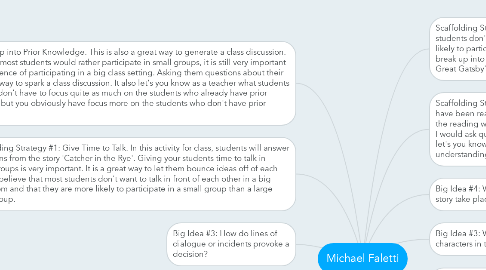Michael Faletti
by Mike Falletti

1. Scaffolding Strategy #2: Give Time to Talk. Like I said to the left, many students don't like to participate in a big group setting, but are more likely to participate in small groups. In this instance, the students will break up into small groups and discuss questions about the story 'The Great Gatsby'.
2. Scaffolding Strategy #1: Pause, Ask Questions, Pause, Review. In this activity for class we would have been reading 'The Great Gatsby'. We would do popcorn reading after key moments in the the reading we would pause for a few seconds, I would review what went on in the story and then I would ask questions to the class about what we read. I think this is very important because it let's you know as a teacher whether or not the students are processing the information and understanding it.
3. Big Idea #4: Where does this story take place?
4. Big Idea #3: Who are the main characters in the story?
5. Big Idea #2: How do complex characters advance the plot through their dialogue?
6. Big Idea #1: How do complex characters interact with other characters?
7. CCSS.ELA‐LITERACY.RL.9‐10.3
8. Analyze how complex characters (e.g., those with multiple or conflicting motivations) develop over the course of a text, interact with other characters, and advance the plot or develop the theme.
9. Scaffolding Strategy #2: Tap into Prior Knowledge. This is also a great way to generate a class discussion. Even though I believe that most students would rather participate in small groups, it is still very important to give students the experience of participating in a big class setting. Asking them questions about their prior knowledge is a great way to spark a class discussion. It also let's you know as a teacher what students you need to focus on. You don't have to focus quite as much on the students who already have prior knowledge on the subject, but you obviously have focus more on the students who don't have prior knowledge.
10. Scaffolding Strategy #1: Give Time to Talk. In this activity for class, students will answer questions from the story 'Catcher in the Rye'. Giving your students time to talk in small groups is very important. It is a great way to let them bounce ideas off of each other. I believe that most students don't want to talk in front of each other in a big classroom and that they are more likely to participate in a small group than a large class group.
11. Big Idea #3: How do lines of dialogue or incidents provoke a decision?
12. Big Idea #2: How do lines of dialogue or incidents reveal aspects about a character in a story?
13. 8th Grade English
14. Analyze how particular lines of dialogue or incidents in a story or drama propel the action, reveal aspects of a character, or provoke a decision.
15. Standard: CCSS.ELA-Literacy.RL.8.3
16. Big Idea #1: How do lines of dialogue or incidents propel the action in a story?


